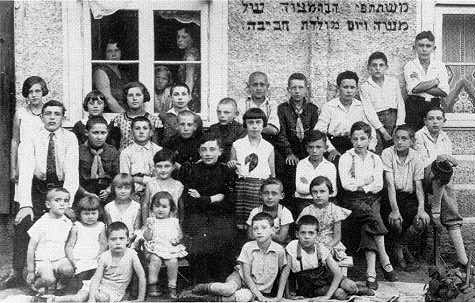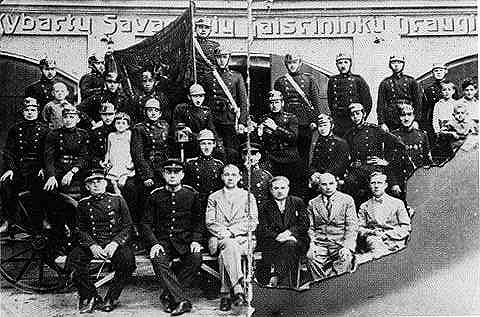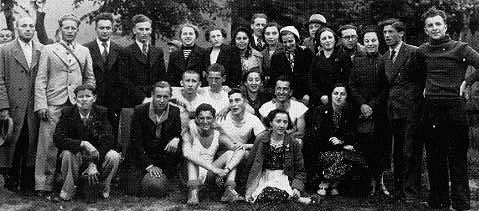
|
The Voluntary Fire Brigade, with remarkable Jewish participation, should be mentioned. Its station, in the main street near the government elementary school, had a wooden tower five stories high and on it a siren for alarming the volunteers. There was a storeroom with one or two water tanks mounted on a cart, a stand by hand pump activated by four people, also ordinary water containers and long hoses. When a fire broke out the firemen would stop passing carts, untie their horses and harness them to their equipment. This was taken for granted and a common custom.
Shoemaker Tzibulsky was among the Jews who for many years continued to do their duty in the fire brigade, and as such was decorated with many medals of distinction and for some time was even the chief of the brigade. Berniker the manufacturer also held this position for many years.

First line from right: Yechiel Feferman, Shmuel P., David Levin, Dov Shtern, Yitzhak Skrobiansky, ---,Hadasa Bartenshtein, Frida Shtern, Aya Chashman
Second line: Iser Kahanov, Aryeh Miltz, Yitzhak Rabinovitz, ---, Shlomovitz, Moshe Chlamnovitz, Haviva Chlamnovitz, Peretz Kliatchko, Yitzhak Feinzilber, Chayim Borochovitz, Gotlib Borovik
Third line: Shlomovitz, Mordechai Shtern, ---, ---, ---, Michael Davidson
Fourth line: ---, Yehuda Rabinovitz, ---

First line, sitting from right: ---, Voltchansky, the major Budrevicius, Berniker, the medic Sher
Second line: Tzibulsky, Ch.Jofe, ---, Frenkel------------

First line from right: Beirachovitz, Z.Kovensky, M.Chlamnovitz, A.Shadchanovitz, B.Vidomliansky, S.Frenkel, Gershater, B.Tzichak, R.Yasven, N.Rachmil, R.Berniker, Z.Borochovitz, A.Borochovitz, A.Lakovsky, M.Svirsky
Second line: E.Taburisky, Sh.Bartenshtein, ---, Z.Epshtein, E.Halperin
Third line: Gershater, D.Shadchanovitz, I.Voltchansky, B.Tzichak, ---
Welfare Institutions.
During the German occupation in World War I, many Jewish refugees from Poland arrived in Kibart' and already in 1918 a committee to care for them had been established. This committee cared for them very well, enabling some of them to return to their homes or to go on to other destinations, and for others it cared for their livelihood and existence.
Social help was very developed in Kibart, and the Community Committee had a budget of 10-12 thousand Lit per year for this purpose. After this Committee was closed down its functions were transferred to the "Ezra" institution, which did very well, having among its duties also "Maoth Chitim" (help for the poor for Pesach) and the supply of heating materials for the needy. The chairman of this institution was J.Sh.Chashman for many years (see Table 17).
Over the years the budget for this institution shrunk and by 1935 it was only 5-6 thousand Lit. Taking into account that during the years many rich merchants left and the status of some of the people changed from having been donors to being needy, the activities of the "Ezra" institution were certainly worthy of their name (Ezra- help in Hebrew). There were also poor families who moved from other places to Kibart, thinking that that they would be better of living in Kibart, despite the fact that in their former abodes there were many more Jews. Parallel to the "Ezra" institution was the "Linath-haTzedek" association, whose yearly budget was about 1,500 Lit.
Another association was "Gmiluth Chesed" which granted interest free loans to those in need. Its chairman was Michael Shadchanovitz, who was very active in welfare matters.
The budgets of these institutions were financed from donations and from balls which were organized by local amateurs and sometimes with the help of artist amateurs from nearby towns. On February 8, 1930, for example, a ball took place in the hall of "Palas" cinema in Kibart' on behalf of the "Ezra" institution, with different shows performed by youths from Kibart' and Virbalis and a band from Vilkavishk (see Table 18).
Another institution working on behalf of health care for children was called "OZE." It began its activities in 1925 with a remarkable budget of 3,500 Lit per year, but ten years later its budget had decreased to only 1,500 Lit, with which they nevertheless did much good work. About 30 children received a glass of fresh milk and a roll every day, weak children received cod liver oil and 10-12 children were sent to a summer resort every summer, two doctors voluntarily practicing preventive medicine and giving medical help. The budget for these activities came from monthly donations of about 50 members, from a one-time fund raising affair and from a yearly ball, the income of which was dedicated to "OZE." Another important action of the Kibart' Community at the end of the thirties was to send 10 youngsters to study on its account to the "ORT" vocational schools in Kovno.
Generally Kibart distinguished itself by its generosity not only to local institutions, but "delegates" who came to raise funds for outside institutions did not leave the town empty handed.
In the 1930s the Yiddish "General Jewish Encyclopedia" began to be published. There were 10 subscribers in Kibart' and compared with much bigger Jewish communities this was a remarkable number.
Another example of the nature of Kibart, as a large city was the fact that people addressed each other by their family names - Mr. so and so - and not by a nickname as was common in most of Lithuania. Generally in Lithuania people did not know their neighbors surnames because everybody was called by his nickname, according to the village his grandfather had come from, or by his occupation, or by the name of his mother or grandmother or by a nickname which had been passed on from father to son for generations. Even the Yiddish was a little different in Kibart, the vowels "oi" being pronounced "au" in some words. For example, instead of pronouncing "Boich" (belly) it was pronounced "Bauch" like in German. The letter "H", was pronounced correctly and not like in other places "A" or "O" instead. Also the "Sh" and the "S" were correctly pronounced and not like in other places, mainly in north Lithuania, where these two consonants were mixed up and caused many funny misunderstandings.
|
JewishGen, Inc. makes no representations regarding the accuracy of
the translation. The reader may wish to refer to the original material
for verification.
JewishGen is not responsible for inaccuracies or omissions in the original work and cannot rewrite or edit the text to correct inaccuracies and/or omissions.
Our mission is to produce a translation of the original work and we cannot verify the accuracy of statements or alter facts cited.
 Kibart (Kybartai), Lithuania
Kibart (Kybartai), Lithuania
 Yizkor Book Project
Yizkor Book Project
 JewishGen Home Page
JewishGen Home Page
Copyright © 1999-2026 by JewishGen, Inc.
Updated 15 Mar 2003 by LA